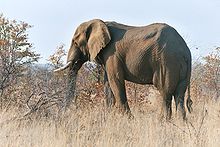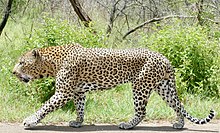Big five game

In Africa, the Big Five game animals are the lion, leopard, rhinoceros, elephant, and African buffalo.[1] The term was coined by big-game hunters to refer to the five most difficult animals in Africa to hunt on foot,[2][3][4] but is now more widely used by game viewing tourists and safari tour operators.[5][2][6] They are examples of charismatic megafauna, featuring prominently in popular culture, and are among the most famous of Africa's large animals.
The 1990 and later releases of South African rand banknotes feature a different big-five animal on each denomination. Countries where all can be found include Angola, Botswana, the Democratic Republic of the Congo, Eswatini, Kenya, Malawi, Mozambique, Namibia, Rwanda, South Africa, Tanzania, Uganda, Zambia and Zimbabwe.[7][8]
Species
[edit]Elephant
[edit]
The African bush elephant (Loxodonta africana) and the African forest elephant (Loxodonta cyclotis) are the largest extant land-based animals. Elephants are herbivores with thick, almost hairless skin; a long, flexible, prehensile trunk; upper incisors forming long, curved, ivory tusks; and large, fan-shaped ears. Elephants are difficult to hunt because, despite their large size, they are able to hide in thick bush and are more likely to charge than the other Big Five species. They become aggressive when their young are threatened.[9]
Rhinoceros
[edit]
The black rhinoceros (Diceros bicornis) and the white rhinoceros (Ceratotherium simum) are large herbivores with two upright horns on their nasal bridge. The black rhino is classified as critically endangered and the white rhino as near threatened, and both are subject to extensive poaching. Among big-five game hunters, the black rhinoceros is more highly prized.[10] The current existing rhinos throughout the savanna are southern white rhinoceros, eastern black rhinoceros, south-western black rhinoceros and south-central black rhinoceros.
African buffalo
[edit]
The African buffalo (Syncerus caffer) is a large horned bovid. It is the only animal among the Big Five that is not on the "endangered" or "threatened" list.[11] The Cape buffalo (Syncerus caffer caffer) is considered by many to be the most dangerous of any of the Big Five:[12] buffalos have reportedly been known to ambush and attack humans.[13]
Lion
[edit]
The lion (Panthera leo) is a large, carnivorous feline found in both Africa and northwestern India. It has a short, tawny coat; a tufted tail; and, in the male, a heavy mane around the neck and shoulders. As a large and charismatic apex predator with cultural significance, lions are among the most popular species to view on safari tours.[14][15][16]
Leopard
[edit]
The leopard (Panthera pardus) is a large, carnivorous feline. Its fur is generally tawny with dark rosette-shaped markings. The leopard is the most seldom seen of the Big Five because of its nocturnal habits (it is most active between sunset and sunrise, although it may hunt during the day in some areas), and because it is wary of humans and will take flight in the face of danger. Leopards can be located in the grasslands, dense brushes, deserts, and forested areas of African savannas.
Conservation status
[edit]Africa's Big Five have become major concerns for wildlife conservationists in recent years. The African lion and African leopard are both classified as vulnerable. The African savanna elephant is listed as endangered by the IUCN as of 2021. The southern white rhinoceros and African buffalo are classified as near threatened while the black rhinoceros is classified as critically endangered.[17]

See also
[edit]References
[edit]- ^ Capstick, Peter H. (1984). Safari, the last adventure. St. Martin's Press. p. 148. ISBN 978-0-312-69657-3.
Generally known as the "Big Five," the group we're talking about comprises lion, leopard, elephant, Cape buffalo and rhino, although not necessarily in that order.
- ^ a b Zijlma, Anouk. "The Big Five: Index". Africa for Visitors. About.com. Archived from the original on 9 February 2007. Retrieved 29 December 2006.
- ^ Capstick, Peter H. (1983). Death in the Dark Continent. St. Martin's Press. p. 13. ISBN 978-0-312-18615-9.
No human being could begin to outrun any of the big five, nor would he last more than a few seconds in any contest of strength.
- ^ Du Toit, Richard (2001). Africa's Big Five. Struik Publishers. ISBN 978-1-86872-582-3.
- ^ "Understanding and Protecting the Big Five in South Africa". goeco.org. Retrieved 14 December 2018.
- ^ Nelson, Marsea. "Ten Wild Facts about the "Big Five"". www.worldwildlife.org. worldwildlife.org. Retrieved 14 December 2018.
- ^ Planet, Lonely (28 October 2013). "Lonely Planet's Best in Travel 2014 - top 10 countries". lonelyplanet.com.
- ^ "Rhinos Return to Rwanda's Akagera National Park after 10 Years". ugandatravelblog.com. 2 May 2017. Archived from the original on 20 July 2018. Retrieved 2 May 2017.
- ^ Fodor's African Safari, 1st Edition: From Budget to Big Spending Where and How to Find the Best Big Game Adventure in Southern and Eastern Africa. Fodor's. 2004. p. 142. ISBN 978-1-4000-1234-3.
- ^ "Current Zoology" (PDF). Archived (PDF) from the original on 27 January 2022.
- ^ Stumpf, Bruce G. "Africa on the Matrix: The Cape Buffalo". Archived from the original on 20 December 2002. Retrieved 23 October 2010.
- ^ Wieland, Terry (2006). Dangerous-Game Rifles. Countrysport Press. p. 286. ISBN 978-0-89272-691-2.
- ^ "African Animals Hunting facts and tips - Buffalo Hunting". safariBwana newsletter. Archived from the original on 8 July 2013. Retrieved 23 October 2010.
- ^ Capstick, Peter H. (1984). Safari, the last adventure. St. Martin's Press. p. 165. ISBN 978-0-312-69657-3.
- ^ "African Lion". safaribwana.com. Archived from the original on 16 April 2016. Retrieved 1 October 2010.
- ^ Robinson, Steve (2008). "Unpleasant Truth About Canned Shooting". shakariconnection.com. Shakari Connection. Retrieved 2 October 2010.
- ^ "Diceros bicornis".
